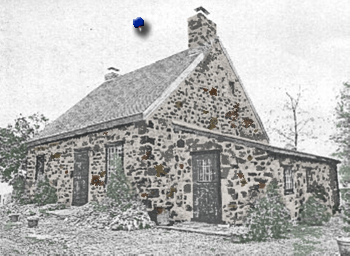Étienne Patenaude
and Angélique Lamarre.
Étienne Patenaude and Angélique Lamarre appeared before the notaire Marien Tailhandier on 23 November 1721 to finalize their marriage contract.
They were wed the next day in Longueuil, where they raised their children in the company of their large, extended families. Our ancestor Véronique was the eleventh, born on 11 October 1741. Her uncle André Lamarre stood as her godfather.
A New Church.
Charles LeMoyne (II) and his descendants were elevated to a barony on 26 Jan. 1700 by Louis XIV. His castle on the Saint-Lawrence River at Longueuil was a well-fortified stronghold and was customary, he provided a mill where the habitants could grind their grains. The Catholic parish of Saint-Antoine-de-Padoue was founded there in 1698.
In 1723 LeMoyne proposed a new church "to build in the place where it pleases the said Sgr. De Longueuil as designer" and called upon the residents to pitch in with labor and supplies. "...Each of the inhabitants will provide a barrel of lime and stone and sand, as agreed in the assembly of the eighth November, one thousand seven hundred and twenty-two, that the foundation masonry would be done by the day and that the said church would be eighty feet long and forty feet wide with two chapels..." The stone walls were to be two feet thick at the base. André Lamarre dit St-André and Étienne Patenaude were among those who signed the agreement.

The finishing touches were arranged a few years later as plans for the pews were agreed upon. Habitants were expected to provide the planks necessary to construct the benches, which were then rented to parishioners for a year. For a row on the side of the pulpit, François Lanctôt's 3rd bench cost him 25 livres, Mathieu Gervais' 10th bench was 27 livres. Étienne Patenaude's 1st bench in the middle went for 35 livres.
In time the church was destroyed by fire, and was rebuilt around 1810. That structure was later cannabalized to build the new cathedral in 1885.
Maçon.

"François, ... hired his cousin Etienne, master mason to build
that house, around 1723. This house was classified as a
historical monument by the Québec Government in 1977"
Étienne was a master mason, constructing homes from stones cut in local quarries. As a "master" he employed others to work in his shop. At least one of his buildings, pictured here, has stood the test of time.
He appears in the 1765 census, taken after the fall of Montréal to the British five years earlier. He is listed below his brothers Joseph and Nicholas.
This census did not name all the occupants, merely indicated by hash marks that he had a house, where one man and one woman lived along with one male below the age of 15 and a total of five women (a couple of his daughters were unmarried at the time). He farmed 30 arpens of the 40 he possessed. Four oxen, three cows, two bulls, three horses and eight pigs rounded out his holdings.
Étienne Patenaude was 70 when he died in Longueuil on 27 May 1768. His burial record indicates he was un chantre de Longueuil, or cantor in the church. Marie-Angélique Lamarre dit Saint-André's burial record was not located, but she was alive at the marriage of her son Charles-Louis in November 1770.
- Jetté, René, Dictionnaire généalogique des familles du Quebec des origines à 1730 (Montréal: Les Presses de l'Université de Montréal, 1983)
- Histoire de Longueuil et de la Famille de Longueuil, Alex. Jodoin, and J. L. Vincent, Montréeal, 1880
- Concession by Monsieur de Longueuil to Charles Patenaude Concession by Monsieur de Longueuil to Charles Patenaude on October 12, 1696; #3031; notary: Claude Maugue
- Maison Patenaude https://www.patrimoine-culturel.gouv.qc.ca/rpcq/detail.do?methode=consulter&id=92425&type=bien
- 1765 recensement: https://digitalcollections.ucalgary.ca/Browse/Collections?#/SearchResult&VBID=2R3BXZSJ7CIFR&PN=1&WS=SearchResults
